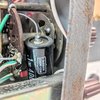I picked up this from a for sale group (these were the photos on the site)



I was immediately attracted to the cut off twin flex!
The guy who sold it to me told me it has been sitting in a shelf for years since his sister bought it from a school sale. So no real idea of the history of the scope, but at least it hasn't been "tested".
The first thing I did was test for continuity through the transformer and shorts to the case. There were no obvious problems, so that's a good start.
Google couldn't tell me anything about the Maxtern model 539 oscilloscope (if anyone does, then please pass it on). It looks like a fairly simple "budget" scope.
Opening it is simply a case of removing 2 screws, in on the underside, and another on the back.


After that the whole case slides off.
But what is that control between the two trimmers? It doesn't want to move. That's of because all the other controls seem really smooth.

Aside from some dust, it's in pretty good condition inside


Now I can see that control at the back is a switch, and with enough force it turns (I thought it was a pot). But something is weird. There's wires hanging there. Are they cut?

There's not a lot of room to see what's in there

It seems to be a puzzle to solve later...
The tubes are all Toshiba brand and the Caps also appear to be "good" makes. I removed all the valves and got some compressed air to clean out the dust. Much better!

Oh, I forgot to show you underneath

This was before cleaning. Very little dust.
And the high voltage filter caps give us a date

The transformer has the windings marked and seems to be in great condition

There's 6 valves in this scope.
And 2 suspect looking paper caps, a 0.2uF 400V oil/paper caps, and a 0.2uf? 600V "oil" cap.
I think the dual 0.2uF 1500V cap looks like a film capacitor.



I was immediately attracted to the cut off twin flex!
The guy who sold it to me told me it has been sitting in a shelf for years since his sister bought it from a school sale. So no real idea of the history of the scope, but at least it hasn't been "tested".
The first thing I did was test for continuity through the transformer and shorts to the case. There were no obvious problems, so that's a good start.
Google couldn't tell me anything about the Maxtern model 539 oscilloscope (if anyone does, then please pass it on). It looks like a fairly simple "budget" scope.
Opening it is simply a case of removing 2 screws, in on the underside, and another on the back.


After that the whole case slides off.
But what is that control between the two trimmers? It doesn't want to move. That's of because all the other controls seem really smooth.
Aside from some dust, it's in pretty good condition inside


Now I can see that control at the back is a switch, and with enough force it turns (I thought it was a pot). But something is weird. There's wires hanging there. Are they cut?

There's not a lot of room to see what's in there

It seems to be a puzzle to solve later...
The tubes are all Toshiba brand and the Caps also appear to be "good" makes. I removed all the valves and got some compressed air to clean out the dust. Much better!

Oh, I forgot to show you underneath
This was before cleaning. Very little dust.
And the high voltage filter caps give us a date

The transformer has the windings marked and seems to be in great condition

There's 6 valves in this scope.
- 6X4 full wave rectifier
- 1X2B 1/2 wave EHT rectifier
- 6AQ8 double triode
- 6AU6 pentode
- 6DJ8 dual high transconductance triode
- 12AU7 dual triode
And 2 suspect looking paper caps, a 0.2uF 400V oil/paper caps, and a 0.2uf? 600V "oil" cap.
I think the dual 0.2uF 1500V cap looks like a film capacitor.
Last edited:









